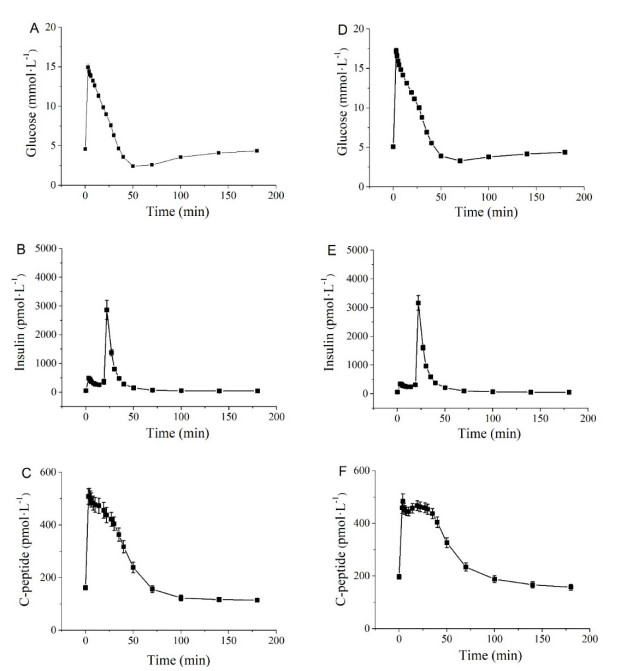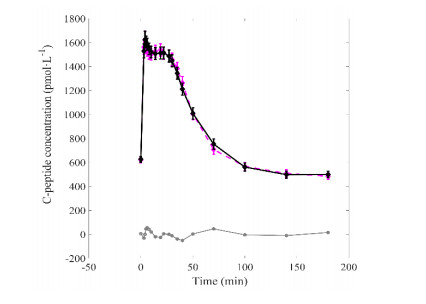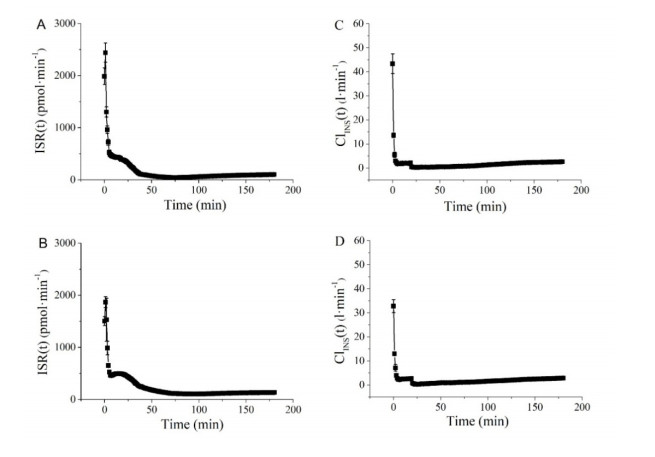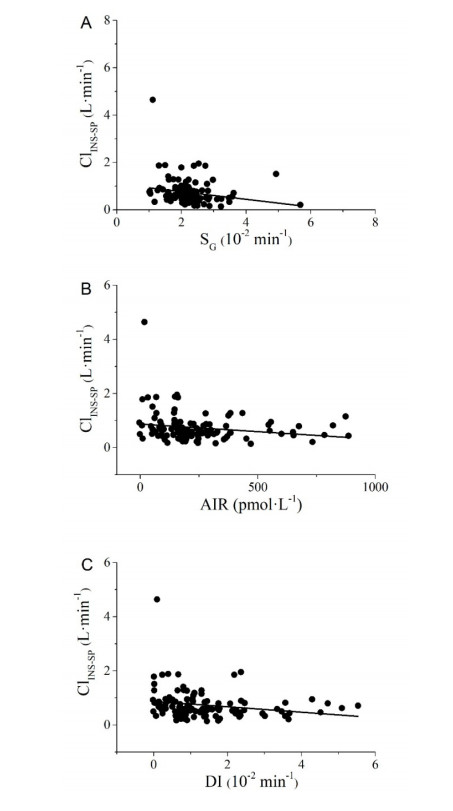Women with a previous history of gestational diabetes mellitus (GDM) have increased risk of developing GDM in future pregnancies (i.e. recurrent GDM) and also Type 2 Diabetes (T2D). Insulin clearance represents one of the processes regulating glucose tolerance but has been scarcely investigated for its possible impairment in high-risk subjects. The aim of this study was to identify possible determinants of insulin clearance in women with a previous history of GDM. A detailed model-based analysis of a regular 3-hour, insulin-modified intravenous glucose tolerance test (IM-IVGTT) has been performed in women with a previous history of GDM (pGDM, n = 115) and in women who had a healthy pregnancy (CNT, n = 41) to assess total, first-phase and second-phase insulin clearance (ClINS-TOT, ClINS-FP and ClINS-SP) and other metabolic parameters (insulin sensitivity SI, glucose effectiveness SG, beta-cell function and disposition index DI). CLINS-SP was found increased in pGDM with respect to CNT and was found significantly inversely linearly correlated with SG (r = -0.20, p = 0.03, slope: -16.2, 95% CI -30.9 to -1.4, intercept: 1.1, 95% CI 0.7–1.4) and also with DI (r = -0.22, p = 0.02, slope: -10.0, 95% CI -18.5 to -1.6, intercept: 0.9, 95% CI 0.7–1.3). Disposition index, accounting for the combined contribution of insulin sensitivity and beta-cell function, and glucose effectiveness were identified as possible determinants of insulin clearance in women with a previous history of GDM. This may be of relevance for more accurate estimation and prevention of the risk for recurrent GDM and T2D.
Abbreviations: GDM: Gestational diabetes mellitus; T2D: Type 2 diabetes; IM-IVGTT: Insulin-modified intravenous glucose tolerance test; SEM: Standard error of the mean; IQR: Interquartile range; ANCOVA: Analysis of covariance
1.
Introduction
Gestational diabetes mellitus (GDM) is defined as a glucose tolerance disorder with onset during pregnancy and is associated with increased feto-maternal morbidity as well as long-term complications in mother and child [1]. In particular, women with history of GDM have increased risk of developing GDM in future pregnancies (i.e. recurrent GDM) and also type 2 diabetes (T2D) [2]. It has been also shown that factors identified as independent determinants of recurrent GDM are the same as those that predict the progression to T2D after GDM [3]. Thus, identification of underlying impairment in such women might allow more effective prevention of GDM recurrence-thus reducing perinatal morbidity by early diagnosis and optimal treatment of recurrent GDM during the subsequent pregnancy - but also of T2D development. To this aim, early postpartum examination of glycemic status in women with history of GDM is strongly encouraged [3].
The increased risk in women with history of GDM has been shown to be correlated with underlying impairment of insulin sensitivity and beta-cell function, which are physiological processes regulating glucose tolerance [4,5,6,7]. Insulin sensitivity is defined as the ability of dynamic insulin response to stimulate glucose uptake and reduce glucose production whereas beta-cell function represents the ability of the pancreatic beta-cells to secrete an adequate amount of insulin. Recent evidence showed that glucose effectiveness, a physiological process taking place independently from any change in insulin, is impaired in women with history of GDM [8]. Insulin clearance represents a further process regulating glucose tolerance. In fact, insulin clearance modulates plasma insulin concentration, being the latter determined by a balance between the insulin secreted by the pancreatic beta-cells and the insulin cleared, mainly by the liver, but also by the kidneys, and other tissues [9].
In spite of its importance in glucose homeostasis and differently from the other processes, the role of insulin clearance in the deterioration of glucose tolerance has been underestimated and thus scarcely investigated for possible impairment in high-risk subjects. Thus, the aim of this study was to identify possible determinants of insulin clearance in women with a previous history of GDM. To this aim, a detailed model-based analysis of insulin clearance has been provided, together with other metabolic parameters, in women with a previous history of GDM, compared to a group of women that had healthy pregnancy.
2.
Materials and methods
2.1. Subjects
This study is a secondary analysis of existing data collected in agreement with the Declaration of Helsinki and upon approval of the respective local ethics committees [6]. A population of 156 women was considered. All women were analyzed early postpartum (4-6 months after delivery) and were classified in two groups on the basis of their pregnancy: Women with previous GDM (pGDM, n = 115; age range 20-43 years, body weight range 49.0-130.8 kg, body mass index range 19.1-48.6 kg/m2) and women that remained healthy during pregnancy (CNT, n = 41; age range 20-47 years, body weight range 50.0-106.8 kg, body mass index range 17.8-41.7 kg/m2). At the post-partum visit, all women underwent a regular 3-hour, insulin-modified intravenous glucose tolerance test (IM-IVGTT); glucose was injected at time 0-0.5 min (0.3 g/kg) and insulin (0.03 U/kg, Humulin R; Eli Lilly, Indianapolis, IN) was infused intravenously at time 20 for 5 min [6]. Blood samples were collected before the glucose infusion (-15 min) and during the subsequent 3 hours (at min 0, 3, 4, 5, 6, 8, 10, 14, 19, 22, 27, 30, 35, 40, 50, 70, 100, 140, 180) for the measurement of glucose (mmol·L-1), insulin (pmol·L-1) and C-peptide (pmol·L-1) plasma concentrations. For every subject mean glucose (Gmean), insulin (Imean) and C-peptide (CPmean) concentrations during the IM-IVGTT were evaluated as the areas under the curve divided by the test duration.
2.2. Model-based assessment of insulin clearance: Dynamics and average values
Insulin clearance dynamics during the IM-IVGTT (ClINS(t)) has been assessed through the model-based procedure reported in Figure 1. In details, ClINS(t) has been obtained as the ratio, every minute from 0 to 180 min, between the prehepatic insulin secretion rate ISR(t) and the plasma insulin concentration I(t), the latter obtained by linear interpolation of plasma insulin concentrations during the IM-IVGTT:
where ISR(t) is, by definition, equal to the C-peptide secretion rate (CPSR(t)), being C-peptide co-secreted with insulin in equimolar amount but not extracted by the liver to a significant extent. CPSR(t) has been computed according to Van Cauter et al. [10] by deconvolution from plasma C-peptide concentration (which minimizes the sum of the squared C-peptide residuals) using individualized C-peptide kinetic parameters computed for each woman on the basis of her anthropometric characteristics. ClINS(t) is expressed as (L·min-1) whereas ISR(t) and CPSR(t) as (pmol·min-1).
Total (ClINS-TOT), first- (ClINS-FP) and second-phase (ClINS-SP) insulin clearance (L·min-1) were also computed for each woman as follows:
using the trapezoidal rule.
2.3. Assessment of metabolic status: Insulin sensitivity, beta-cell function and glucose effectiveness
Besides insulin clearance, a complete characterization of glucose tolerance has been achieved by assessing insulin sensitivity, beta-cell function and glucose effectiveness. The minimal model analysis of IM-IVGTT data provided assessment of insulin sensitivity (SI, min-1/(μU·ml-1)) and glucose effectiveness (SG, min-1) [11].
Beta-cell function was described by the Acute Insulin Response (AIR) and the Acute C-Peptide Response (ACPR) as the mean of suprabasal insulin and C-peptide curve, respectively in the time interval 3-8 min during the IM-IVGTT test.
To account for the combined contribution of insulin sensitivity and beta-cell function to glucose tolerance regulation, the Disposition Index (DI) has been computed according to Kahn et al. [12] as follows:
2.4. Statistical analysis
The Kolmogorov-Smirnov test was used to evaluate the hypothesis that each variable had a normal distribution with unspecified mean and variance. Normally distributed variables were presented as mean ± standard error of the mean (SEM); skewed distributed variables were presented as median [interquartile range, IQR]. The coefficient of variation (computed as the ratio between standard deviation and mean, expressed as percentage) was used to quantify the inter-individual variability for model parameters. Differences in mean values of variables between the two groups were tested by using the unpaired Student’s t-test. In addition, Analysis of Covariance (ANCOVA) was performed to control for the effect of age and body weight in determining the differences in insulin clearance between the two groups. Univariable linear regression analysis was used to assess the association between parameters describing insulin clearance and the other metabolic parameters. For skewed distributed variables, tests were applied to the log-transformed values. The two-sided significance level was set at 5% (p < 0.05).
3.
Results
Main characteristics of the participants are reported in Table 1. Plasma glucose, insulin and C-peptide concentrations measured during the IM-IVGTT in CNT and pGDM groups are reported in Figure 2. Cumulative results (pGDM and CNT grouped together) of the best-fit of plasma C-peptide concentration data are reported in Figure 3. The resulting ISR(t) and ClINS(t) in each group are reported in Figure 4.
Insulin-clearance average values and characterization of the metabolic status for CNT and pGDM groups are reported in Table 2. Difference observed in ClINS-SP remained statistically significant (p = 0.04) when controlling for body weight and for age.
In CNT and pGDM grouped, no significant correlation was found between ClINS-TOT and SI, SG, AIR, ACPR and DI. Similarly, no significant correlation was found between CLINS-FP and SI, SG, and ACPR, whereas a significant inverse correlation was found between CLINS-FP and AIR (r = -0.48; p < 0.001), and between CLINS-FP and DI (r = -0.35, p < 0.001). For CLINS-SP, no significant correlation was found with SI and with ACPR whereas a significant inverse correlation was found with SG (r = -0.20, p = 0.01), DI (r = -0.19, p = 0.02) and AIR (r = -0.19, p = 0.02).
When considering the pGDM group, a significant correlation was found between CLINS-FP and AIR (r = -0.46; p < 0.001), and between CLINS-FP and DI (r = -0.35, p < 0.001). With regard to CLINS-SP (Figure 5), it was found inversely correlated with SG (r = -0.20, p = 0.03, slope: -16.2, 95% CI -30.9 to -1.4, intercept: 1.1, 95% CI 0.7-1.4), with AIR (r = -0.20, p = 0.03, slope: -5.6 × 10-4, 95% CI -1.08 × 10-3 to -3.8 × 10-5, intercept: 0.9, 95% CI 0.7-1.0) and also with DI (r = -0.22, p = 0.02, slope: -10.0, 95% CI -18.5 to -1.6, intercept: 0.9, 95% CI 0.7-1.3).
4.
Discussion
This study identified possible determinants of insulin clearance in women with a previous history of GDM by providing a detailed model-based analysis of insulin clearance, together with other metabolic parameters characterizing the processes regulating glucose tolerance. The main result of this study is that disposition index and glucose effectiveness determine changes in second-phase insulin clearance, which (although slightly) appears increased in women with former GDM compared to healthy control women.
In women with former GDM, impairment in insulin sensitivity and insulin secretion/beta-cell function have been reported in several studies [4,5,6,7,13] and have been confirmed here. However, results of this study showed that insulin sensitivity by itself does not represent a determinant for insulin clearance (neither total, nor first- and second-phase) but has to be considered together with beta-cell function through the disposition index, which represents an integrated index that more reliably quantifies the combined contribution of such processes in the regulation of glucose tolerance.
Glucose effectiveness has been shown to be impaired in women with a previous history of GDM [8]. Another key result of this study is that glucose effectiveness as well represents a determinant for insulin clearance. In particular, as detected by their inverse correlation, a decrease in glucose effectiveness determines an increase in insulin clearance (at least for the second phase).
Ten minutes after glucose injection was selected to separate the first- and second-phase clearance since it represents the commonly used cut-off point to separate first- and second-phase beta-cell insulin response after a rapid intravenous glucose challenge [14]. Of note, first phase can be clearly identified only when the beta-cell is exposed to a rapidly changing glucose stimulus, like the one induced by a brisk intravenous glucose administration; in contrast, under physiological conditions, i.e., when glucose is given orally, first and second phase are not clearly distinguishable [15]. Thus, first- and second-phase insulin clearance can be assessed by using the methodology here presented anytime an IVGTT (either regular or modified) is carried out.
In GDM, hyperglycemia quickly disappears after pregnancy (as soon as the placenta is delivered), thus timing of the post-partum tests may be critical. However, subclinical alterations in glucose metabolism (e.g. impaired insulin resistance or subtle defects in beta-cell function [4,5,6,7]) can persist during months and years and might be associated with an increased risk for the later development of T2D in these patients. Actual guidelines [16] recommend a re-examination of glucose metabolism until three months after delivery. However, as the adherence level for the postpartum tests is generally low, for the sake of this study it was decided to extend this period to six months in accordance with other studies [17].
It should be noted that insulin clearance is a highly regulated process, also at genetic level, and hence insulin clearance is partially genetically coded independently from insulin secretion or other metabolic variables [18,19,20]. However, insulin clearance has been found altered in subjects with T2D [21] and results of this study detected the presence of alterations also in women with a previous history of GDM, which are at high risk of developing T2D. In this population, the possible determinants of such alterations are those indicated above. The assessment of insulin clearance and its determinants in women with former GDM, together with the other metabolic parameters, could be relevant to identify appropriate strategies for reducing the risk of developing T2D (but also recurrent GDM), since it may allow a more effective adjustment of pharmacological treatment. Changes in insulin clearance have to be considered when adjusting for insulin therapy in women with former GDM, since insulin clearance affects insulin delivery to the peripheral tissues. Moreover, insulin clearance could be modified by some specific antidiabetic agents, that could be added to the insulin therapy (e.g. those acting on the incretin axis (DPP-4 inhibitors [22] and GLP-1 receptor agonists [23]). Indeed, some recent studies have shown a connection between incretins, incretin-based pharmacological agents, and insulin clearance in mice [24,25]. A connection between incretins and insulin clearance was also shown in humans after bariatric surgery [26].
As the other glucose tolerance components [27], insulin clearance may be affected by body weight. However, results of our analysis showed that differences observed in second-phase insulin clearance between former GDM and healthy control women remained statistically significant even when controlling for body weight.
Very few studies analyzed insulin clearance in women with a previous history of GDM and, to the best of our knowledge, this is the first study focusing on assessing insulin clearance determinants. However, this study has some limitations, mainly linked to the methodology used for the assessment of insulin clearance. First, the two-compartment model used to describe C-peptide kinetics [28], although widely accepted, represents an approximation that could influence quantification of insulin clearance. Such quantification could be also affected by the kinetics parameters used in the C-peptide model [10]. In addition, hepatic and extrahepatic insulin clearance have been shown to be differentially regulated [9] but in this study only the whole-body insulin clearance was assessed. On the other hand, performing an accurate assessment of insulin clearance at different tissues would require complex experiments and estimation procedure [9,29], hardly feasible in large datasets.
5.
Conclusion
In conclusion, disposition index and glucose effectiveness were identified as possible determinants of insulin clearance in women with former GDM. This may be of relevance for more accurate estimation and prevention of the risk for recurrent GDM and T2D.
Conflict of Interest
All authors declare no conflicts of interest in this paper.
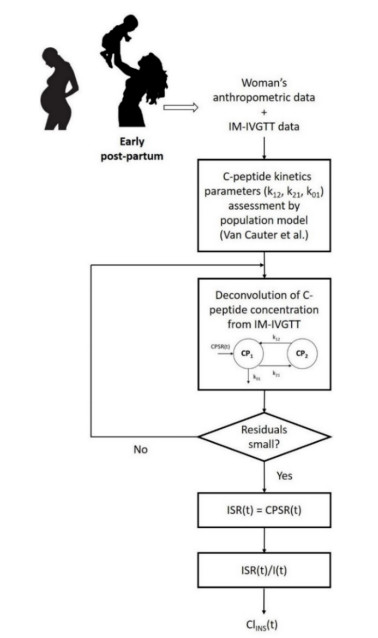









 DownLoad:
DownLoad:
